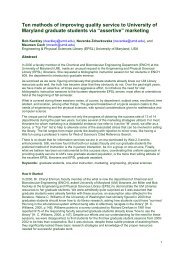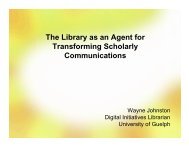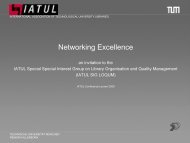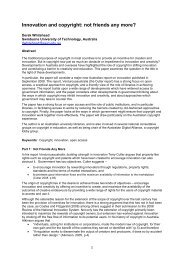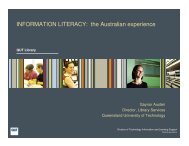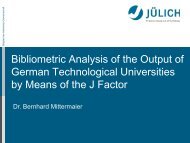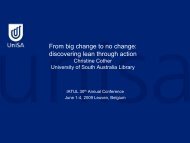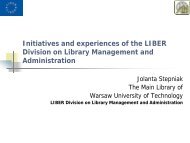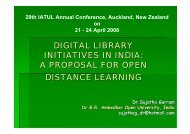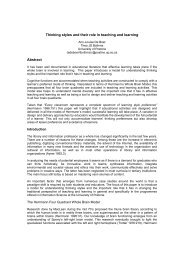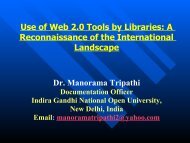PDF Document - IATUL
PDF Document - IATUL
PDF Document - IATUL
Create successful ePaper yourself
Turn your PDF publications into a flip-book with our unique Google optimized e-Paper software.
created. It was determined to be critical that the Libraries’<br />
administrative positions reflect the goals of the University –<br />
learning, discovery, and engagement – rather than assume a<br />
more traditional administrative structure. Hence, the decision<br />
was made to restructure positions, for example, creating the<br />
Associate Dean for Learning, replacing the previous Director<br />
for Public Services. New positions were created, such as the<br />
Associate Dean for Research. Three additional positions<br />
comprise the Libraries administration: Associate Dean for<br />
Planning and Administration; Associate Dean for Collections<br />
and Information Resources; and Associate Dean for<br />
Information Technology.<br />
The Associate Dean for Research position quickly evolved<br />
from the Interdisciplinary Research Librarian initially<br />
designed to relate and identify more closely with<br />
interdisciplinary, collaborative sponsored research endeavors.<br />
The Dean of Libraries and the Interdisciplinary Research<br />
Librarian met with virtually every department and center on<br />
campus in an effort to understand the research agenda within<br />
each department /center; through this effort it was possible to<br />
see potential connections between departmental research<br />
needs and library/librarian partnerships.<br />
Purdue University has a council that represents universitywide<br />
research interests. The Dean of Libraries sits on the<br />
council; at the first meeting, however, it was noted that other<br />
council members were Associate Deans. This led to the<br />
decision that the relevant person to represent the Libraries<br />
was an individual associated with research. The logical<br />
individual was the Interdisciplinary Research Librarian, but<br />
council participation was restricted to dean level positions.<br />
The Interdisciplinary Research Librarian became the first<br />
Associate Dean for Research, more effectively reflecting the<br />
significance of this position within the university, and also<br />
making the individual in that position eligible to sit on, and<br />
contribute to, the council. It has been greatly beneficial to<br />
have the ADR serving on the University Research Council for<br />
it has provided access to discussions occurring at the highest<br />
levels within the research area of the university, and has<br />
enabled the message about the librarians; abilities,<br />
willingness, and desire to collaborate on sponsored research<br />
to expand.<br />
While serving on the council was important, the strongest<br />
need for the ADR was the Libraries’ new role in exploring<br />
collaboration on sponsored research projects with academic<br />
departments in the sciences, engineering and technology.<br />
The new ADR position, in part, replicates the structure and<br />
responsibilities within these academic departments. The<br />
Dean of Libraries met with Deans and Department Heads of<br />
the related departments, to propose and demonstrate this new<br />
working relationship and link between the departments and<br />
the libraries. Without exception, the concept was well<br />
received by the Deans and Department Heads. The ADR<br />
then set meetings with faculty and researchers. The<br />
responses have been successful in fact the new challenge is<br />
addressing the number of requests that are being received to<br />
create collaborative research proposals with librarians as a<br />
joint principal investigator. To date, joint proposals have<br />
been submitted by departments in Biology, Chemical<br />
Engineering, and Electrical/Computer Engineering.<br />
In the spring of 2005 no members of the Purdue Libraries<br />
faculty were involved in collaborative, interdisciplinary<br />
research projects. One year later, in the spring of 2006,<br />
eleven Purdue Libraries faculty were involved in<br />
interdisciplinary research projects. The image and relevance<br />
of librarians has been enhanced and their reputation is<br />
growing among faculty colleagues, particularly in the<br />
sciences, engineering, and technology. The Associate Dean<br />
for Research in is a key individual in this new and dynamic<br />
environment.<br />
To enable the ADR to respond quickly to the expectations<br />
placed upon the Libraries to support the challenge of massive<br />
data sets, in early 2006 the Libraries began the search for two<br />
Data Research Scientists. The description for these positions<br />
is closely modelled on the Data Scientist described above.<br />
These positions will be funded up-front for three years by the<br />
Libraries, with the assumption that by the end of the three<br />
years both positions will be completely funded through<br />
external grants. The first Data Research Scientist is expected<br />
to be in place in the summer of 2006. The primary role of the<br />
Data Research Scientist will be to collaborate with faculty<br />
colleagues on sponsored research projects as well as<br />
furthering the Purdue Libraries’ research agenda in the areas<br />
of taxonomy, ontology, and metadata as they relate to the<br />
management of massive data sets.<br />
Conclusion:<br />
In less than two years the challenge of managing massive data<br />
sets at Purdue University has moved from the purview only<br />
of computer scientists and technologists, to being highly<br />
visible in the arena of librarians. It portends a great future for<br />
the field of librarianship - while the 20 th century may be<br />
recognized as the golden age of libraries, the 21 st may be<br />
remembered as the golden age of librarians!<br />
References<br />
[1] National Science Board, “Long-Lived Digital Data<br />
Collections Enabling Research and Education in the 21st<br />
Century”, pp.27, (2005).



